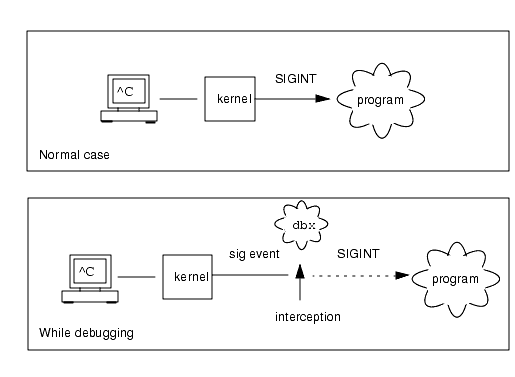| Debugging a Program With dbx |
Working With Signals
This chapter describes how to use
dbxto work with signals.dbxsupports thecatchcommand, which instructsdbxto stop a program whendbxdetects any of the signals appearing on the catch list.The
dbxcommandscont,step, andnextsupport the-sigsignal_name option, which lets you resume execution of a program with the program behaving as if it had received the signal specified in thecont-sigcommand.This chapter is organized into the following sections.
- Understanding Signal Events
- Catching Signals
- Sending a Signal in a Program
- Automatically Handling Signals
Understanding Signal Events
When a signal is to be delivered to a process that is being debugged, the signal is redirected to
dbxby the kernel. When this happens, you usually receive a prompt. You then have two choices:
- "Cancel" the signal when the program is resumed--the default behavior of the
FIGURE 14-1 Intercepting and Cancelling the SIGINT Signalcontcommand--facilitating easy interruption and resumption withSIGINT(Control-C) as shown in FIGURE 14-1.
- "Forward" the signal to the process using:
cont -sigsignalIn addition, if a certain signal is received frequently, you can arrange for
dbxto forward automatically the signal because you do not want it displayed:
ignoresignal# "ignore"However, the signal is still forwarded to the process. A default set of signals is automatically forwarded in this manner (see "ignore Command" in the Using dbx Commands section of the Sun WorkShop online help).
Catching Signals
By default, the catch list contains many of the more than 33 detectable signals. (The numbers depend upon the operating system and version.) You can change the default catch list by adding signals to or removing them from the default catch list.
To see the list of signals currently being trapped, type
catchwith no signal argument.
(dbx)catchTo see a list of the signals currently being ignored by
dbxwhen the program detects them, typeignorewith no signal argument.
(dbx)ignoreChanging the Default Signal Lists
You control which signals cause the program to stop by moving the signal names from one list to the other. To move signal names, supply a signal name that currently appears on one list as an argument to the other list.
For example, to move the
QUITandABRTsignals from the catch list to the ignore list:
(dbx)ignore QUIT ABRTTrapping the FPE Signal
Often programmers working with code that requires floating point calculations want to debug exceptions generated in a program. When a floating point exception like overflow or divide by zero occurs, the system returns a reasonable answer as the result for the operation that caused the exception. Returning a reasonable answer lets the program continue executing quietly. Solaris implements the IEEE Standard for Binary Floating Point Arithmetic definitions of reasonable answers for exceptions.
Because a reasonable answer for floating point exceptions is returned, exceptions do not automatically trigger the signal
SIGFPE.To find the cause of an exception, you need to set up a trap handler in the program so that the exception triggers the signal
SIGFPE. (Seeieee_handler(3m) man page for an example of a trap handler.)
ieee_handlerfpsetmask(see thefpsetmask(3c) man page)-ftrapcompiler flag (for FORTRAN 77 and Fortran 95, see thef77(1) andf95(1) man pages)When you set up a trap handler using the
ieee_handlercommand, the trap enable mask in the hardware floating point status register is set. This trap enable mask causes the exception to raise theSIGFPEsignal at run time.Once you have compiled the program with the trap handler, load the program into
dbx. Before you can catch theSIGFPEsignal, you must addFPEto thedbxsignal catch list.
(dbx)catch FPEBy default,
FPEis on the ignore list.Determining Where the Exception Occurred
After adding
FPEto the catch list, run the program indbx. When the exception you are trapping occurs, theSIGFPEsignal is raised anddbxstops the program. Then you can trace the call stack using thedbxwherecommand to help find the specific line number of the program where the exception occurs (see "where Command" in the Using dbx Commands section of the Sun WorkShop online help).Determining the Cause of the Exception
To determine the cause of the exception, use the
regs -fcommand to display the floating point state register (FSR). Look at the accrued exception (aexc) and current exception (cexc) fields of the register, which contain bits for the following floating-point exception conditions:
- Invalid operand
- Overflow
- Underflow
- Division by zero
- Inexact result
For more information on the floating-point state register, see Version 8 (for V8) or Version 9 (for V9) of The SPARC Architecture Manual.For more discussion and examples, see the Numerical Computation Guide.
Sending a Signal in a Program
The
dbxcontcommand supports the-sigsignal option, which lets you resume execution of a program with the program behaving as if it had received the system signal signal.For example, if a program has an interrupt handler for
SIGINT(^C), you can type^Cto stop the application and return control todbx. If you issue acontcommand by itself to continue program execution, the interrupt handler never executes. To execute the interrupt handler, send the signal,sigint, to the program:
(dbx)cont -sig intThe
step,next, anddetachcommands accept-sigas well.Automatically Handling Signals
The event management commands can also deal with signals as events. These two commands have the same effect.
(dbx)stop sig signal(dbx)catchsignalHaving the signal event is more useful if you need to associate some pre-programmed action.
(dbx)when sig SIGCLD {echo Got $sig $signame;}In this case, make sure to first move
SIGCLDto the ignore list.
(dbx)ignore SIGCLD
|
Sun Microsystems, Inc. Copyright information. All rights reserved. Feedback |
Library | Contents | Previous | Next | Index |